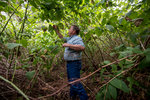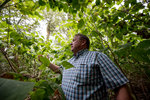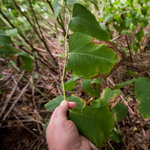


When it comes to knotweed, it’s about controlling the invasive plant — because eradicating it just isn’t possible at this point.
Mostly using herbicide, the Lewis County Noxious Weed Control Board has been battling knotweed for about 10 years now.
For eight of those years, weed technician Denise Wagner has been on the frontlines trying to keep the weeds from overtaking 30 miles of the Chehalis River.
“I’m totally obsessed with this,” she said.
Each year she surveys and maps growths and then has about three months to knock down as much of the noxious weed as she can with limited funds and only in Lewis County right of way or areas with landowners’ permission.
Wagner works weekends, hiking miles on trails she blazes herself through thick brush. So far this year Wagner has attacked patches on 95 sites owned by private residents. She has another 125 on her list for this summer.
“It’s crunch time,” she said.
Each plant must be coated for the broad-spectrum systemic acting glyphosate herbicide called AquaMaster to be effective, and some patches can take a week to treat.
But knotweed is relentless and many of those sites will likely see new plants next year.
So she returns to some locations for years in a row, keeping the area under control. Patches can be skipped for a year, she estimates, but any longer than that and the plants will be ruling the land again.
“If you let it go, it’s going to come back,” she said.
But she says the battle is worth it because if left alone knotweed can grow quickly, densely and up to 12 feet tall, choking out native species and impacting water quality, making for poor aquatic habitat for wildlife.
“There’s a lot of interest in it now because of its impact to fisheries,” said Bill Wamsley, control board coordinator.
The Chehalis River is a focus for the weed control board, and Wagner has seen knotweed growing in the middle of fields that were hit by flooding, which transplanted the weed.
Animals and improper disposal also move knotweed to new locations.
While Wagner is able to get the species pretty well under control on the Chehalis River from Pe Ell to Ceres Hill Road, east of that fewer landowners have been willing to allow access, she said.
Wamsley said treatments have been very effective on smaller tributaries such as the South Fork Chehalis River and Deep Creek.
Wagner said 5 years ago there was a 2-mile stretch that was completely consumed on Deep Creek. After hitting it with the herbicide, it’s under control.
However, the Tilton River and Olequa Creek are basically overrun by the plant, Wagner told The Chronicle, and weed control doesn’t have the funds to go after those areas.
The attacks on the weed have been primarily grant funded, with the weed control board putting about $10,000 of a two-year $20,000 Washington State Department of Agriculture grant toward the fight each year on the Chehalis and Cowlitz rivers.
Wamsley said it’s best to hit knotweed later in the summer as the herbicide is more effective then. Treatment usually begins in mid to late July and continues until just before the frost moves into the area.
The herbicide is Department of Ecology and Environmental Protection Agency approved, and doesn’t affect water health. But it can impact native plants, so application is made cautiously. The Weed Control Board makes an effort to post signs in public access areas where applications have been made.
Cutting is not very effective in reducing knotweed, but digging up small infestations of plants can help. However, Wamsley warns that residents should be careful when disposing the weeds to not accidently transplant it as small fragments can sprout new roots.
Herbicide application is the most effective, but applying near waterways requires a state license and permit. Because of these requirements, it can be difficult for landowners to battle knotweed on their property.
Right now there is no known biological control, such as an insect that would take out knotweed after it’s established.
“There’s no silver bullet. We wish there was,” Wagner said.
Knotweed is native to Asia and has a bamboo-like stem with smooth-edged, spade-shaped leaves and can grow up to 12 feet tall. Root fragments as small as 0.5-inches can start new plants.
While the fight against knotweed may be Lewis County’s biggest battle against invasive plants, it also deals with issues of garlic mustard, Scotch broom, tansy ragwort, elodea and other non-native species.
People with knotweed can call the Lewis County Noxious Weed Control Board at (360) 740-1215.